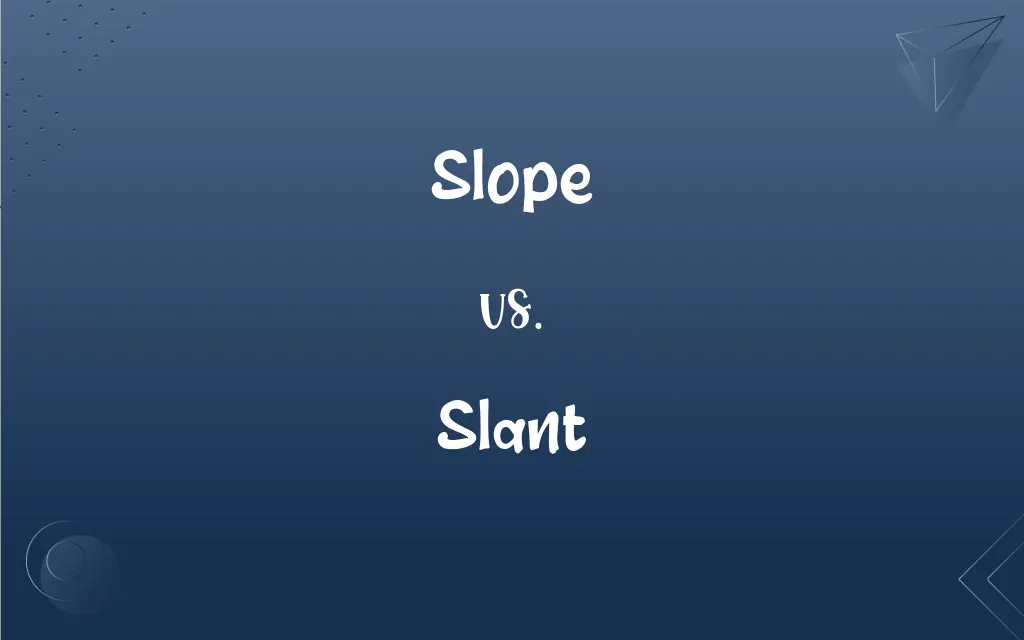Slope vs. Slant: What's the Difference?
Edited by Harlon Moss || By Janet White || Updated on October 4, 2023
Slope refers to the steepness or gradient of a surface, while slant refers to a tilt or inclination from the vertical or horizontal direction.

Key Differences
A slope is generally understood as the degree of steepness or incline of a particular surface. It can be calculated mathematically as the "rise over run". On the other hand, slant typically refers to the angle or way something deviates from a straight line, especially when it tilts.
In many contexts, slope is a term commonly associated with geography, geology, or mathematics. For instance, hills and mountains have slopes. Slant, conversely, has a broader usage and can describe not just physical angles, but also biases in writing or reporting.
While slope often has a more precise, numerical implication — like the slope of a line in algebra — slant might be used in a more subjective manner. For example, news stories can have a slant, meaning they are presented with a particular bias.
Architecturally, a slope might refer to the gradient of a roof or road. In literature or journalism, however, a slant might refer to the unique angle or perspective from which a story is told.
It's important to note that while both slope and slant can often be used interchangeably in casual conversation, their technical definitions differ. A slope usually pertains to an actual measure of steepness, while a slant refers more to a direction of inclination.
ADVERTISEMENT
Comparison Chart
Definition
Degree of steepness or incline of a surface.
Tilt or inclination from vertical/horizontal.
Common Usage
Geography, mathematics, architecture.
Literature, journalism, general description.
Precision
Often has a specific, calculable measure.
Might be more subjective or qualitative.
Associated Imagery
Hills, mountains, roads.
Angled lines, biases, story perspectives.
Implication
Typically implies a measurable gradient.
Can imply a direction of inclination or bias.
ADVERTISEMENT
Slope and Slant Definitions
Slope
A measure of steepness represented as a ratio.
The slope of that line is 3:1.
Slant
A particular point of view or bias in presenting information.
The article had a political slant.
Slope
The angle at which a linear function rises or falls.
In algebra, determining the slope is crucial for understanding linear functions.
Slant
The direction in which something deviates from the upright.
The sun cast shadows at a slant as it set.
Slope
A piece of ground that inclines.
The house was built on a gentle slope.
Slant
A sloping direction or angle.
The artist used slant lines for dynamism in his work.
Slope
The gradient of a curve at a particular point.
The slope of the curve at this point indicates rapid growth.
Slant
To give a direction other than perpendicular or horizontal to; make diagonal; cause to slope
She slants her letters from upper right to lower left.
Slope
To diverge from the vertical or horizontal; incline
A roof that slopes.
Slant
To present so as to conform to a particular bias or appeal to a certain audience
The story was slanted in favor of the strikers.
Slope
To move or walk
"Without another word he turned and sloped off down the driveway" (Roald Dahl).
Slant
To have or go in a direction other than perpendicular or horizontal; slope.
Slope
To cause to slope
Sloped the path down the bank.
Slant
A line, plane, course, or direction that is other than perpendicular or horizontal; a slope.
Slope
An inclined line, surface, plane, position, or direction.
Slant
A sloping thing or piece of ground.
Slope
A stretch of ground forming a natural or artificial incline
Ski slopes.
Slant
(Printing) A virgule.
Slope
A deviation from the horizontal.
Slant
A personal point of view or opinion
An article with an unconventional slant.
Slope
The amount or degree of such deviation.
Slant
A bias
An anti-religious slant.
Slope
The rate at which an ordinate of a point of a line on a coordinate plane changes with respect to a change in the abscissa.
Slant
Offensive Slang Used as a disparaging term for a person of East Asian birth or ancestry.
Slope
The tangent of the angle of inclination of a line, or the slope of the tangent line for a curve or surface.
Slant
A slope; an incline, inclination.
The house was built on a bit of a slant and was never quite level.
Slope
Offensive Slang Used as a disparaging term for a person of East Asian birth or ancestry.
Slant
A sloped surface or line.
Slope
An area of ground that tends evenly upward or downward.
I had to climb a small slope to get to the site.
A steep slope
Slant
(mining) A run: a heading driven diagonally between the dip and strike of a coal seam.
Slope
The degree to which a surface tends upward or downward.
The road has a very sharp downward slope at that point.
Slant
(typography) slash, particularly in its use to set off pronunciations from other text.
Slope
(mathematics) The ratio of the vertical and horizontal distances between two points on a line; zero if the line is horizontal, undefined if it is vertical.
The slope of this line is 0.5
Slant
An oblique movement or course.
Slope
(mathematics) The slope of the line tangent to a curve at a given point.
The slope of a parabola increases linearly with x.
Slant
(biology) A sloping surface in a culture medium.
Slope
The angle a roof surface makes with the horizontal, expressed as a ratio of the units of vertical rise to the units of horizontal length (sometimes referred to as run).
The slope of an asphalt shingle roof system should be 4:12 or greater.
Slant
A pan with a sloped bottom used for holding paintbrushes.
Slope
A person of Chinese or other East Asian descent.
Slant
A depression on a palette with a sloping bottom for holding and mixing watercolours.
Slope
(intransitive) To tend steadily upward or downward.
The road slopes sharply down at that point.
Slant
A palette or similar container with slants or sloping depressions.
Slope
(transitive) To form with a slope; to give an oblique or slanting direction to; to incline or slant.
To slope the ground in a garden;
To slope a piece of cloth in cutting a garment
Slant
A sarcastic remark; shade, an indirect mocking insult.
Slope
To try to move surreptitiously.
I sloped in through the back door, hoping my boss wouldn't see me.
Slant
(slang) An opportunity, particularly to go somewhere.
Slope
(military) To hold a rifle at a slope with forearm perpendicular to the body in front holding the butt, the rifle resting on the shoulder.
The order was given to "slope arms".
Slant
A crime committed for the purpose of being apprehended and transported to a major settlement.
Slope
(obsolete) Sloping.
Slant
A point of view, an angle.
It was a well written article, but it had a bit of a leftist slant.
Slope
(obsolete) slopingly
Slant
(US) A look, a glance.
Slope
An oblique direction; a line or direction including from a horizontal line or direction; also, sometimes, an inclination, as of one line or surface to another.
Slant
A person with slanting eyes, particularly an East Asian.
Slope
Any ground whose surface forms an angle with the plane of the horizon.
Buildings the summit and slope of a hill.
Under the slopes of Pisgah.
Slant
(ambitransitive) To lean, tilt or incline.
If you slant the track a little more, the marble will roll down it faster.
Slope
The part of a continent descending toward, and draining to, a particular ocean; as, the Pacific slope.
Slant
(transitive) To bias or skew.
The group tends to slant its policies in favor of the big businesses it serves.
Slope
Sloping.
A bank not steep, but gently slope.
Slant
To lie or exaggerate.
Slope
In a sloping manner.
Slant
Sloping; oblique; slanted.
Slope
To form with a slope; to give an oblique or slanting direction to; to direct obliquely; to incline; to slant; as, to slope the ground in a garden; to slope a piece of cloth in cutting a garment.
Slant
To be turned or inclined from a right line or level; to lie obliquely; to slope.
On the side of younder slanting hill.
Slope
To take an oblique direction; to be at an angle with the plane of the horizon; to incline; as, the ground slopes.
Slant
To turn from a direct line; to give an oblique or sloping direction to; as, to slant a line.
Slope
To depart; to disappear suddenly.
Slant
A slanting direction or plane; a slope; as, it lies on a slant.
Slope
An elevated geological formation;
He climbed the steep slope
The house was built on the side of the mountain
Slant
An oblique reflection or gibe; a sarcastic remark.
Slope
The property possessed by a line or surface that departs from the horizontal;
A five-degree gradient
Slant
Inclined from a direct line, whether horizontal or perpendicular; sloping; oblique.
Slope
Be at an angle;
The terrain sloped down
Slant
A biased way of looking at or presenting something
Slope
The incline or decline of a surface.
The mountain's slope was challenging for beginners.
Slant
Degree of deviation from a horizontal plane;
The roof had a steep pitch
Slant
Lie obliquely;
A scar slanted across his face
Slant
Present with a bias;
He biased his presentation so as to please the share holders
Slant
To incline or bend from a vertical position;
She leaned over the banister
Slant
Heel over;
The tower is tilting
The ceiling is slanting
Slant
A tilt or inclination from the vertical.
The monument had a slight slant to the left.
Slant
A way of looking at or considering a matter.
She offered a unique slant on the topic during the discussion.
FAQs
How do you calculate the slope?
In mathematics, slope is often calculated as "rise over run" or the change in y over the change in x.
Can slant be used to refer to a bias in writing?
Yes, slant can refer to a particular bias or perspective in presenting information.
Can roads have a slope?
Yes, roads can have a slope which is important for drainage and safety considerations.
Does slant always imply a negative bias?
No, a slant can be neutral, positive, or negative depending on the context.
Can buildings have a slant?
Yes, some architectural designs may feature buildings with a slant or tilt for aesthetic or functional reasons.
Can a story have a slant?
Yes, a story can have a slant, meaning it's presented from a specific viewpoint or with a bias.
Is the slope always measurable?
In many contexts, especially math and geography, the slope is measurable. However, in casual use, it may simply imply incline.
What is a "negative slope"?
In mathematics, a negative slope indicates that as one variable increases, the other decreases.
Is a slope always steep?
No, a slope can be steep or gentle, depending on its gradient.
Is slope used in sports?
Yes, in sports like skiing, the slope refers to the incline of the ski trail.
Does slant mean the same as tilt?
While both words can refer to an inclination, slant can also imply a bias, while tilt typically does not.
Is every incline a slope?
While every incline can be described as having a slope, not every incline is necessarily referred to as a slope in casual conversation.
Can light have a slant?
Yes, light can come in at a slant, especially during sunrise or sunset when the sun is low on the horizon.
Does slant always refer to physical angles?
No, slant can also refer to biases or a particular way of presenting information.
In what subjects is slope frequently discussed?
Slope is commonly discussed in mathematics, geography, and physics.
Can landscapes have a slant?
Landscapes can have inclines or declines, which may be described as having a slant.
Is slant an objective term?
While slant can refer to a measurable angle, it can also be subjective when referring to biases.
Are slope and gradient the same?
Slope and gradient are often used interchangeably to describe the incline of a surface, though gradient might be more commonly used in certain contexts, like road design.
How does slope relate to geometry?
In geometry, slope describes the steepness, incline, or gradient of a line or surface.
Is the term slant used in journalism?
Yes, in journalism, slant refers to the bias or angle from which a story is reported.
About Author
Written by
Janet WhiteJanet White has been an esteemed writer and blogger for Difference Wiki. Holding a Master's degree in Science and Medical Journalism from the prestigious Boston University, she has consistently demonstrated her expertise and passion for her field. When she's not immersed in her work, Janet relishes her time exercising, delving into a good book, and cherishing moments with friends and family.
Edited by
Harlon MossHarlon is a seasoned quality moderator and accomplished content writer for Difference Wiki. An alumnus of the prestigious University of California, he earned his degree in Computer Science. Leveraging his academic background, Harlon brings a meticulous and informed perspective to his work, ensuring content accuracy and excellence.































































